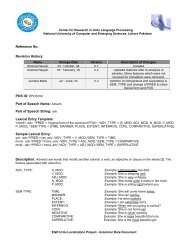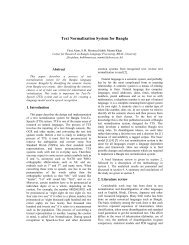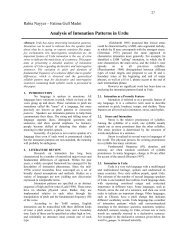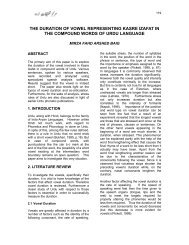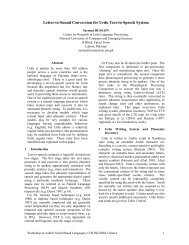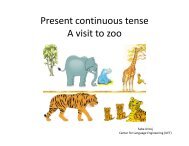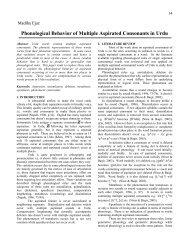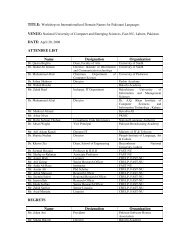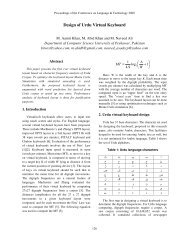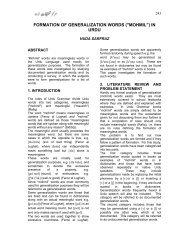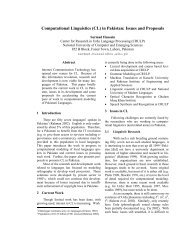phonological analysis of nicknaming in urdu - Center for Language ...
phonological analysis of nicknaming in urdu - Center for Language ...
phonological analysis of nicknaming in urdu - Center for Language ...
Create successful ePaper yourself
Turn your PDF publications into a flip-book with our unique Google optimized e-Paper software.
286<strong>Center</strong> <strong>for</strong> Research <strong>in</strong> Urdu <strong>Language</strong> Process<strong>in</strong>gto follow<strong>in</strong>g three different syllable structuresunpredictably.1. CVV CVV2. CVC CVV3. VC CVVThe data <strong>of</strong> the English name Ada is shownbelow.TABLE 27: Examples <strong>of</strong> bi-syllabic names fromother languages.Name Nick Trans. Prob.Ada Dama da ma .4Ada Aedi æ di .1Ada Aadam a dm .2Ada Dunno dn no .1Ada Aadi a di .2And we can see that the nick rule wasapplicable but if we changed the consonantslike <strong>in</strong> ‘Dunno’ and then there can be no ruleapplicable.Now let us turn our attention to a nameThomas that has the same syllable structureas <strong>of</strong> ‘Tahir’. For Tahir people <strong>for</strong>meddifferent nicks but <strong>for</strong> Thomas they wereunable to <strong>for</strong>mulate. There was a largevariability <strong>in</strong> the nicknames <strong>for</strong>med by thepeople.TABLE 28: Variations <strong>in</strong> bi-syllabic name from otherlanguages.Name Nick Trans.Thomas Thom to mThomas Thomy to miThomas Tom mThomas Tony niThomas Thomu to muAs we can see that the all the possibletrans<strong>for</strong>mations were same as <strong>for</strong> the Urdunames and if the consonants are notchanged then the nick rule is applicable.5.5 Effects <strong>of</strong> surround<strong>in</strong>gsThere is no particular rule <strong>for</strong> nicknames.However it is sometimes that the physicalappearance leads to some nickname. Also itis possible that you give some nick justbecause you heard it somewhere elsecorrespond<strong>in</strong>g to that name and you liked it.It is also possible that you have heard somenick without know<strong>in</strong>g its orig<strong>in</strong>al name andthen you give that nick to any name withoutany reason.Let us look at the names <strong>of</strong> the fewcricketers like Graham, Bret and Dannis.TABLE 29: Table show<strong>in</strong>g nickname names thathave no connection with the names.Name Structure NicknameTranscriptionStructureDannis CVV Lilly ll li CVCCVCCVVGraham CVV Gary a ri CVVCVCCVVBret CCVC Lee li CVVAllan VV CVC Dona o na CVVCVVNow see the nickname aga<strong>in</strong>st Dannis. It issometh<strong>in</strong>g totally unrelated. It is because thedata provider knew the cricketers withsecond name and that he liked the secondname because it’s already on the syllabicstructure on nicknames. So he <strong>for</strong>med thenick <strong>of</strong> the ‘Dannis’ simply ‘lilly’. Same is thecase with Bret and Allan. Allan was giventhe nickname donna which cannot have any<strong>phonological</strong> relation to that name.6. REFERENCES• Azevedo, Milton. 1981. A ContrastivePhonology <strong>of</strong> Portuguese and English.Wash<strong>in</strong>gton, D.C.: GeorgetownUniversity Press• Hale, Kissock and Riss, ‘Evaluat<strong>in</strong>g theEmpirical Basis <strong>for</strong> Output-OutputCorrespondence’ (web resource)• Laderfoged,Peter. A Course <strong>in</strong>phonetics. Harcourt Brace Jovanovichcollege publishers.



